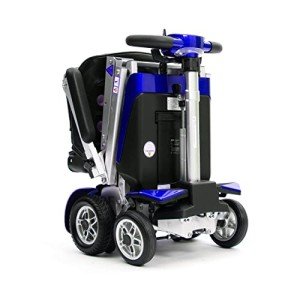10 Tell-Tale Symptoms You Need To Get A New Mobility Scooter

A Comprehensive Guide to Buying a Mobility Scooter
Mobility scooters have ended up being a crucial tool for many people wanting to boost their self-reliance and mobility. With a huge range of designs and features offered, choosing the ideal mobility scooter can be intimidating. This article provides an informative guide to help customers browse their choices, evaluate their needs, and make a notified purchase.
Understanding Mobility Scooters
Mobility scooters are electric cars developed for people who experience mobility obstacles. They are particularly helpful for elders, those with impairments, or individuals recovering from injuries. Mobility scooters can differ commonly in terms of style, features, and prices.
Kinds Of Mobility Scooters
Before embarking on a purchase, it's vital to understand the different types of mobility scooters offered:
Three-Wheel Scooters:
- Generally more maneuverable in tight spaces
- Lightweight and portable
- Suitable for indoor usage
Four-Wheel Scooters:
- Offer greater stability and balance
- Suitable for outside usage over various surfaces
- Typically have a longer battery life
Foldable/Portable Scooters:
- Designed to be quickly carried and stored
- Can typically fit in the trunk of a vehicle
- Perfect for those who travel frequently
Sturdy Scooters:
- Built to accommodate bigger people
- Frequently come with more robust features for outdoor use
- Typically geared up with bigger batteries for prolonged range
Factors to Consider When Buying a Mobility Scooter
1. Weight Capacity
Choose a mobility scooter that can support the user's weight. Many scooters have a weight limitation varying from 250 to 500 pounds. It is essential to ensure that the scooter can accommodate the user conveniently.
2. Range and Battery Life
The range is how far the mobility scooter can take a trip on a single charge. Normal varieties vary in between 10 to 30 miles. Consider the user's day-to-day activities and choose a scooter with an ideal variety.
3. Scooter Dimensions
Consider the size of the scooter, including its weight and measurements. A more compact scooter may be perfect for narrow corridors and tight spaces, while larger models provide extra stability and comfort.
4. Terrain Capability
Examine where the scooter will mainly be utilized. If the user plans to travel mostly on pavement, a lightweight design may be adequate. Nevertheless, if the user requires to pass through gravel or unequal surface areas, consider a four-wheel scooter constructed for off-road use.
Leading Features to Look For
Convenience
- Adjustable Seats: Look for scooters with cushioned and height-adjustable seats to guarantee convenience throughout travel.
- Armrests: These enhance safety and assistance while navigating.
Safety and Visibility
- Headlights and Taillights: Essential for nighttime use.
- Turn Signals and Reflectors: Improve presence and security while on the road.
User-Friendly Controls
- Joystick or Drive Controls: These ought to be instinctive and simple to control.
- Easy-to-Read Displays: A control panel that shows battery life, speed, and distance can boost the user experience.
Additional Features
- Storage Compartments: These offer included convenience for carrying individual items while on the go.
- Weather condition Protection: Consider models with rain covers or windshields if utilized in variable weather condition conditions.
Cost Considerations
When budgeting for a mobility scooter, rates can range anywhere from ₤ 500 to over ₤ 5,000 depending upon the design, features, and brand. Additional expenses may consist of:
- Extended Warranty: Protects versus flaws and can conserve money in the long run.
- Accessories: Optional functions, such as updated seats, lights, or storage options.
| Function | Expense Range |
|---|---|
| Standard Models | ₤ 500 - ₤ 1,500 |
| Mid-Range Models | ₤ 1,500 - ₤ 3,000 |
| High-End Models | ₤ 3,000 - ₤ 5,000 |
Funding Options
Numerous merchants provide funding strategies, and some regional federal government efforts may supply grants or assistance for those in requirement. Examine prospective monetary assistance with community resources or mobility service companies.
FAQs about Buying a Mobility Scooter
What is the difference in between a mobility scooter and a wheelchair?
Mobility scooters are motorized and permit users to navigate separately, while wheelchairs might require physical help or manual operation.
How do I maintain a mobility scooter?
Routine maintenance includes inspecting battery life, cleaning the scooter, and inspecting tires and brakes. Always refer to the user manual for specific guidelines.
Can mobility scooters be used inside your home?
Yes, many models are designed for both indoor and outdoor usage. However, three-wheel scooters tend to be much better suited for indoor navigation due to their tighter turning radius.
Are mobility scooters covered by insurance coverage?
Some insurance coverage plans cover a portion of the expenses for mobility scooters if they are deemed medically necessary. Contact your service provider for specific details.
How fast can a mobility scooter go?
Most mobility scooters have a maximum speed varying from 4 to 8 miles per hour. However, the proper rate may vary depending upon regional regulations.
Buying a mobility scooter can considerably improve one's independence and lifestyle. By comprehending the types, functions, and costs connected with mobility scooters, prospective buyers can make well-informed decisions that match their requirements and preferences. Personalization and thorough research are crucial to ensuring complete satisfaction with this important investment.

